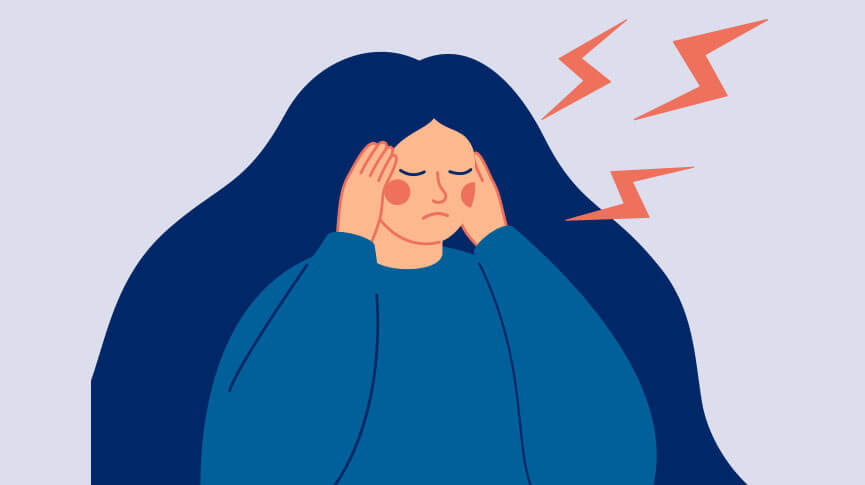Menstrual Migraines: Why and What to Do

Ah, the wonders of menstruation. As cool as the female body can be, it can also come with a whole lot of hiccups.
If you’ve made it here, chances are you’ve experienced a few periods in your day and are wondering how to make them more manageable, comfortable, and possibly even enjoyable. That’s especially true if you experience PMS or period pain or discomfort, whether that be cramps, bloating, and in some cases – migraines.
What is a Menstrual Migraine?
Migraines are more than a bad headache, it is an actual neurological disorder that can greatly affect someone’s well-being and lifestyle. About 70% of people who experience migraines are cis-women or AFAB (assigned female at birth). Of these people, between 60% to 70% of them say that their migraines tend to coincide with their period.
This is what’s called a menstrual migraine, also known as a hormonal migraine. They tend to occur up to three days before or during your period and may last for two or three days. Ouch! For some people, this happens every month, while others they only get them occasionally.
Symptoms of a menstrual migraine may include:
● Dizziness
● Fatigue
● Severe pulsing headache
● Dull throbbing headache
● Sensitivity to light
● Loss of appetite
● Tender scalp
● Sensitivity to noise
● Sweating or chills
● Nausea and vomiting
● Pain on one side of your head
Menstruation isn’t the only cause of hormonal migraines. They can also occur for people during menopause. One possible treatment for migraines during menopause is hormone replacement therapy to supplement low estrogen levels.
What Causes Hormonal Migraines?
Your endocrine system regulates your body’s chemical messengers, also known as hormones. When your hormones are off balance they can lead to all sorts of issues including thyroid disorders, Polycystic Ovarian Syndrome (PCOS), and other menstrual disorders.
Hormone levels fluctuate all the time, especially for people who menstruate. The main hormones we see fluctuating during the hormonal cycle are progesterone and estrogen. Estrogen steadily decreases in the second half of your menstrual cycle, reaching its lowest point during your period.
This drop in estrogen is the main culprit when it comes to hormonal migraines. Many people who get hormonal migraines during PMS get them when estrogen levels are at the lowest point in their cycle.
Some people experience hormonal migraines after starting new hormonal birth control. If this happens to you, you may want to ask your provider about switching or going off hormonal birth control altogether.
How to Treat a Menstrual Migraine
Migraines are not something to take lightly. Before beginning any sort of treatment protocol, it’s important to see your provider for a proper diagnosis.
They will assess self-reported symptoms, the severity and frequency of your migraines if anything triggers them besides your menstrual cycle, and what you normally do to treat them. It may be necessary to perform CT or MRI imaging and take blood tests to rule out other potential causes of your migraines.
The most common treatments for immediate menstrual migraine relief includes include:
● Taking NSAID pain relievers like Ibuprofen and Naproxen
● Resting and getting enough sleep
● Avoiding light and noise
● Taking magnesium supplements (which can also help with cramps)
● Staying hydrated
● Limiting alcohol
● Limiting caffeine, although for some people it helps with migraines
● Using a cold or hot compress
● Acupressure and massage
● Taking a warm bath (with the lights off)
● Practice relaxation techniques, like breathing exercises
If you normally get migraines at the same time before or during your period, you can take NSAID pain relievers ahead of time and avoid any other known triggers like movement or excess screen time.
For people who get frequent migraines, whether they’re hormonal or not, there are some more long-term treatment options. Some people have found relief from frequent migraines through the use of:
● Botox injections
● Anti-seizure drugs
● Certain blood pressure medications
● Avoiding any food intolerances
● Acupuncture and other Chinese Medicine Tools
● Managing stress levels
● Regulate blood sugar levels by eating regularly and maintaining a balanced diet
● Biofeedback therapy
● Regular yoga or stretching
Unless there is an underlying disorder that is to blame, menstrual migraines do not cause long term harm. They are, however, incredibly painful and difficult to deal with while they’re happening. Some causes for concern include if the frequency or severity of your migraines increases, you’re experiencing new side effects, or if your medications or normal tools aren’t working anymore.
Do you ever need to go to the emergency room for a menstrual migraine? If you experience on of these symptoms, seek medical help immediately:
● Seizures
● Confusion or difficulty speaking
● Numbing or tingling sensations
● Vision problems
Menstrual migraines can make it nearly impossible to get anything done before or during your period. If you can, take time to rest and nourish your body. As frustrating and painful as they can be, rest is often the best tool to nip migraines in the bud, along with taking steps to prevent them from happening again.

Natasha (she/her) is a full-spectrum doula and health+wellness copywriter. Her work focuses on deconstructing the shame, stigma, and barriers people carry around birth, sex, health, and beyond, to help people navigate through their lives with more education and empowerment. You can connect with Natasha on IG @natasha.s.weiss.


